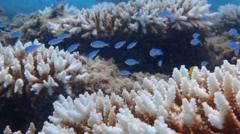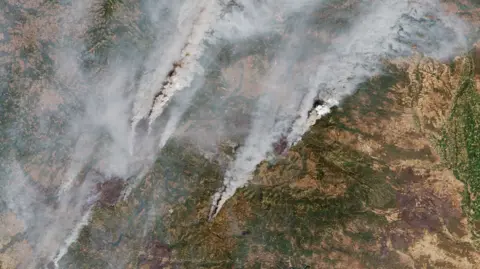The world-renowned coral reefs of Western Australia are experiencing the most severe bleaching event ever documented, driven by the state's "longest, largest, and most intense" marine heatwave, according to scientists. Between last August and this May, elevated water temperatures inflicted substantial heat stress on these delicate ecosystems, leading many corals to expel the vibrant algae that is essential for their survival—a process known as bleaching, which often results in coral mortality. The extensive damage, which will require months of evaluation, encompasses a staggering 1,500 kilometers (approximately 932 miles) of coastline, including regions that had until now been spared the dire impacts of climate change.
Globally, coral reefs have been grappling with a two-year prolonged bleaching crisis sparked by record ocean temperatures. In fact, just eight weeks of heat exposure can prove fatal for coral, with preliminary assessments indicating that Western Australia’s reefs have experienced mortality rates ranging from 15 to 30 percent, as reported by Australia’s marine science authority. "The unprecedented scale and intensity of the heat stress, affecting significant portions of multiple reef regions, is unlike anything we have witnessed before in Western Australia," stated James Gilmour from the Australian Institute of Marine Science (AIMS).
In a recent analysis, AIMS researchers highlighted that the 2024-2025 season has recorded the most extreme coral bleaching ever for WA reefs located in both the northwestern and central regions. Areas that had previously offered hope for conservation, due to minimal bleaching histories—such as the Rowley Shoals, north Kimberley, and Ningaloo Reef—were hit particularly hard this time. "Unfortunately, climate change has finally caught up with these once-robust reefs," Gilmour remarked.
Ningaloo Reef, a UNESCO World Heritage site akin to the Great Barrier Reef located on Australia's eastern coast, has also suffered significant coral loss in recent years. Concurrently, a recent report disclosed that the Great Barrier Reef, the planet's largest coral ecosystem, which spans over 2,300 kilometers (1,429 miles), has seen its most significant coral decline in nearly four decades.
Federal Environment Minister Murray Watt emphasized the situation at Ningaloo as a pressing call to action, asserting that it highlights the necessity for Australia—and the global community—to prioritize actions towards achieving net-zero emissions. As climate change exacerbates the frequency, intensity, and scope of coral bleaching events, Dr. Gilmour warns that coral reefs, which typically require 10 to 15 years to recover, face a diminishing timeframe for regeneration.
The United Nations has previously warned that even with efforts to limit global temperature increases to 1.5 degrees Celsius above pre-industrial levels, between 70 and 90 percent of the planet's tropical coral reefs are projected to perish. For continuous updates on climate and environmental developments, sign up for our Future Earth newsletter featuring the latest insights from the BBC’s Justin Rowlatt.
Globally, coral reefs have been grappling with a two-year prolonged bleaching crisis sparked by record ocean temperatures. In fact, just eight weeks of heat exposure can prove fatal for coral, with preliminary assessments indicating that Western Australia’s reefs have experienced mortality rates ranging from 15 to 30 percent, as reported by Australia’s marine science authority. "The unprecedented scale and intensity of the heat stress, affecting significant portions of multiple reef regions, is unlike anything we have witnessed before in Western Australia," stated James Gilmour from the Australian Institute of Marine Science (AIMS).
In a recent analysis, AIMS researchers highlighted that the 2024-2025 season has recorded the most extreme coral bleaching ever for WA reefs located in both the northwestern and central regions. Areas that had previously offered hope for conservation, due to minimal bleaching histories—such as the Rowley Shoals, north Kimberley, and Ningaloo Reef—were hit particularly hard this time. "Unfortunately, climate change has finally caught up with these once-robust reefs," Gilmour remarked.
Ningaloo Reef, a UNESCO World Heritage site akin to the Great Barrier Reef located on Australia's eastern coast, has also suffered significant coral loss in recent years. Concurrently, a recent report disclosed that the Great Barrier Reef, the planet's largest coral ecosystem, which spans over 2,300 kilometers (1,429 miles), has seen its most significant coral decline in nearly four decades.
Federal Environment Minister Murray Watt emphasized the situation at Ningaloo as a pressing call to action, asserting that it highlights the necessity for Australia—and the global community—to prioritize actions towards achieving net-zero emissions. As climate change exacerbates the frequency, intensity, and scope of coral bleaching events, Dr. Gilmour warns that coral reefs, which typically require 10 to 15 years to recover, face a diminishing timeframe for regeneration.
The United Nations has previously warned that even with efforts to limit global temperature increases to 1.5 degrees Celsius above pre-industrial levels, between 70 and 90 percent of the planet's tropical coral reefs are projected to perish. For continuous updates on climate and environmental developments, sign up for our Future Earth newsletter featuring the latest insights from the BBC’s Justin Rowlatt.


















